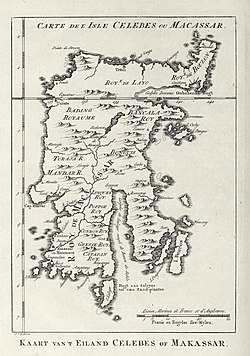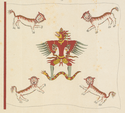Bone State
This article includes a list of references, related reading, or external links, but its sources remain unclear because it lacks inline citations. (April 2009) |
You can help expand this article with text translated from the corresponding article in Indonesian. (August 2014) Click [show] for important translation instructions.
|
Sultanate of Bone | |||||||
|---|---|---|---|---|---|---|---|
| 14th century–1905[1] | |||||||
|
Flag | |||||||
 | |||||||
| Status | Part of Indonesia | ||||||
| Capital | Watampone | ||||||
| Common languages | Bugis | ||||||
| Religion | Sunni Islam | ||||||
| Government | Monarchy | ||||||
| Sultan, Arung Mangkaue' ri Bone | |||||||
• 1300s | Manurunge ri Matajang | ||||||
• 1358-1424 | Petta Panre Bessie | ||||||
• 1672-1696 | Sultan Saaduddin Arung Palakka | ||||||
• 1931-1946 | Andi Mappanyukki | ||||||
| History | |||||||
• Established | 14th century | ||||||
• Loss of independence to the Dutch | 1905[1] | ||||||
| |||||||
| Today part of | Indonesia (as Bone Regency) | ||||||
| History of Indonesia |
|---|
 |
| Timeline |
|
|
Bone (also Boni, or Bone Saoraja) was a sultanate in the south-west peninsula of what is now Sulawesi (formerly Celebes), a province of modern-day Indonesia. It came under Dutch rule in 1905, and was succeeded by the Bone Regency.[1]
Covering an area of 2,600 square kilometres (1,000 sq mi), Bone's chief town Boni, lay 130 kilometres (81 mi) northeast of the city of Makassar, home to the Bugis people.

History
Bone was an adat-based Bugis kingdom whose origins can be traced back to the early 15th century. Its chronicle (as yet unpublished) provides detailed information on its rulers, starting from La Umasa, who ruled in the early 15th century, through to La Tenrtatta, who died in 1699. Under La Umasa and his nephew La Saliu (Kerrépelua) who succeeded him, Bone expanded from a handful of settlements around the modern capital Watampone to a small kingdom roughly one-third the size of Kabupaten Bone (the present regency).
In the early 16th century the kingdom expanded northwards, fighting with Luwu for control of the mouth of the River Cenrana, a major east coast trade exit. In 1582 Bone entered an alliance with the Wajo and Soppeng kingdoms for mutual defence against the rising power of Gowa-Tallo. This alliance became known as Tellumpocco'e (lit. the Three Summits) or LaMumpatue Ri Timurung (lit. The burying of the stones at Timurung).[2]

In 1611, during the reign of the tenth king of Bone We Tenrituppu MatinroE ri Sidenreng, Bone was invaded by the Sultanate of Gowa and pressured to convert to Islam.[3][4] Bone State later enjoyed a period of prosperity in the middle of the 17th century.[2]
Bone became the most powerful state of South Sulawesi under Arung (ruler of) Palakka, La Tenritatta (1634 or 1635 – 1696) who sided with the Dutch admiral Cornelis Speelman against the Makasar kingdom of Goa-Tallo, which led to the defeat and capture of Makassar in 1669. From this year until 1814 when the British temporarily gained power of the region, Bone was by treaty and in practice the overlord of South Sulawesi, with the exception of Dutch-controlled areas on the west and south coast, including the important port-city of Makassar. When the Dutch returned to Makassar in 1816 they attempted to reduce Bone's status from equal to vassal, a move strongly resisted by Bone's rulers.
Following a military defeat during the South Sulawesi expeditions of 1905, the Bone State lost its independence to the Dutch.[5]
In May 1950, the people held demonstrations in Watampone against the royalty and Bone's membership in the State of East Indonesia. This caused the sultan to join Indonesia.[4]
List of rulers
Rulers of Bone used the title Arung Mangkaue' ri Bone (the king who resides in Bone), shortened to Arumpone, MangkauE, or ArungE' ri Bone.
| No | Monarch | Gender | Reign | |
|---|---|---|---|---|
| 1 | Manurunge ri Matajang, Mata Silompoe | Male | 1330 – 1365 (35 years) | |
| 2 | La Ummasa, Petta Panre Bessie | Male | 1365 – 1378 (13 years) | |
| 3 | La Saliyu Korampelua | Male | 1378 – 1450 (72 years) | |
| 4 | We Banrigau, Mallajange ri Cina | Female | 1450 – 1510 (60 years) | |
| 5 | La Tenrisukki, Mappajunge | Male | 1510 – 1535 (25 years) | |
| 6 | La Uliyo Bote-E, Matinroe ri Itterung | Male | 1535 – 1560 (25 years) | |
| 7 | La Tenrirawe Bongkange, Matinroe ri Guccina | Male | 1560 – 1564 (4 years) | |
| 8 | La Inca, Matinroe ri Addenenna | Male | 1564 – 1565 (11 months) | |
| 9 | La Pattawe, Matinroe ri Bettung | Male | 1565 – 1602 (37 years) | |
| 10 | We Tenrituppu, Matinroe ri Bantaeng | Female | 1602 – 1611 (9 years) | |
| 11 | La Tenriruwa, Sultan Adam | Male | 1611 – 1616 (5 years) | |
| 12 | La Tenripale, Sultan Abdullah | Male | 1616 – 1631 (15 years) | |
| 13 | La Maddaremmeng, Sultan Saleh | Male | 1631 – 1644 (13 years) | 1667 – 1672 (5 years) |
| 14 | La Tenriaji, Arungpone | Male | 1644 – 1646 (2 years) | |
| 15 | La Tenritatta Sultan Saaduddin, Arung Palakka | Male | 1672 – 1696 (24 years) | |
| 16 | La Patau Matanna Tikka, Sultan Idris | Male | 1696-1714 (18 years) | |
| 17 | We Bataritoja, Sultanah Zainab Zulkiyahtuddin | Female | 1714 – 1715 (1 year) | |
| 18 | La Padassajati, Sultan Sulaeman | Male | 1715 – 1718 (3 years) | |
| 19 | La Pareppa, Sultan Ismail | Male | 1718 – 1721 (3 years) | |
| 20 | La Panaongi, Arung Mampu | Male | 1721 – 1724 (3 years) | |
| 21 | We Bataritoja, Sultanah Zainab Zulkiyahtuddin | Female | 1724 – 1749 (25 years) | |
| 22 | La Temmassonge, Sultan Abdul Razak | Male | 1749 – 1775 (26 years) | |
| 23 | La Tenritappu, Sultan Ahmad Saleh | Male | 1775 – 1812 (37 years) | |
| 24 | La Mappasessu, Sultan Ismail Muhtajuddin | Male | 1812 – 1823 (11 years) | |
| 25 | We Imaniratu, Sultanah Rajituddin | Female | 1823 – 1835 (12 years) | |
| 26 | La Mappaseling, Sultan Adam Najamuddin | Male | 1835 – 1845 (10 years) | |
| 27 | La Parenrengi, Sultan Ahmad Muhiddin | Male | 1845 – 1857 (12 years) | |
| 28 | We Tenriawaru, Sultanah Ummulhuda | Female | 1857 – 1860 (3 years) | |
| 29 | La Singkeru Rukka, Sultan Ahmad Idris | Male | 1860 – 1871 (11 years) | |
| 30 | We Fatimah Banri, Datu Citta | Female | 1871 – 1895 (24 years) | |
| 31 | La Pawawoi, Karaeng Sigeri | Male | 1895 – 1905 (10 years) | |
| 32 | La Mappanyukki, Sultan Ibrahim | Male | 1931 – 1946 (15 years) | |
| 33 | La Pabbenteng, Matinroe ri Matuju | Male | 1946 – 1951 (5 years) |
See also
Citations
- ^ a b "South Sulawesi". 16 December 2022.
- ^ a b c "Sejarah Kabupaten Bone". Website Resmi Pemerintah Kabupaten Bone (in Indonesian). 2019-12-05. Retrieved 2022-04-18.
- ^ Noorduyn, J. (1987). "Makasar and the Islamization of Bima". Bijdragen tot de Taal-, Land- en Volkenkunde. 143 (2/3): 312–342. doi:10.1163/22134379-90003330. JSTOR 27863842.
The Makasarese king understood the meaning of this and began what is known as the Islamic war, in Makasarese bunduq kasallannganga, by which he succeeded in the next four years in forcing the major Buginese kingdoms to accept Islam one by one, Bone as the last in 1611.
- ^ a b Pamelleri, Riwayat.
- ^ Budiarti, Hari (2007). "Taking and Returning Objects in a Colonial Context: Tracing the Collections Acquired during the Bone-Gowa Military Expeditions". In Pieter J. ter Keurs (ed.). Colonial Collections Revisited. Leiden: CNWS Publications. p. 128.
References
- For the wars in Boni, see Perelaer, De Bonische Expedition, 1859 (Leiden, 1872) (in Dutch); and Meyers, in the Militaire Spectator (1880).
- Chisholm, Hugh, ed. (1911). . Encyclopædia Britannica. Vol. 4 (11th ed.). Cambridge University Press. pp. 205–206.
- Pamelleri, Andi (22 April 2006). "Riwayat Kabupaten Bone" [A Short History of Bone Regency] (PDF) (in Indonesian). Archived from the original (PDF) on 30 August 2019. Retrieved 23 August 2011.
- "South Sulawesi". 16 December 2022.
Further reading
- Macknight, C.; Paeni, M.; Hadrawi, M., eds. (2020). The Bugis Chronicle of Bone. Acton ACT: ANU Press. doi:10.22459/bcb.2020. ISBN 978-1-76046-357-1.

